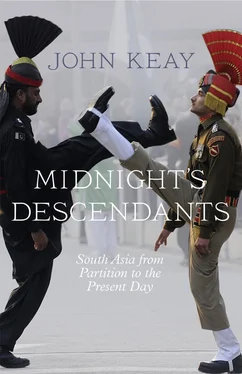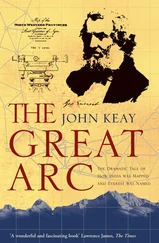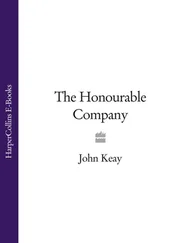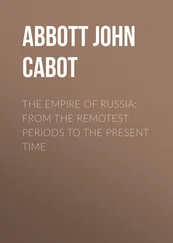All this is in striking contrast to the nearby border between India and Nepal. Here there are no fences, no patrols and minimal formalities. It is an ‘open border’. Although Nepal never came under direct British rule – and was therefore unaffected by Partition – an agreement had been reached whereby people and goods might cross at will. This still stands, albeit often amended. Immigrants from India already make up a substantial percentage of Nepal’s population, while Nepalis settled in India constitute an overall majority in parts of the Indian state of West Bengal. A Gorkha National Liberation Front (GNLF) represents the latter’s interests. Demanding the recognition of Gorkhali, Nepal’s main language, as one of India’s official languages – and so qualifying its speakers for the educational and job opportunities that go with recognition – the GNLF strives, not without occasional violence, for an autonomous enclave within West Bengal or even a separate Nepali state within the Republic of India. Migration, in other words, is here an accepted phenomenon. National identity (‘Nepali-ness’) is being officially downgraded to a linguistic identity (‘Gorkhali-ness’), which is something that can be accommodated within the accepted limits of protest and concession afforded to India’s other language groups.
Language remains a contentious issue throughout polyglot South Asia, but in modern India its explosive potential has been steadily tamed by concessions and circumstance. It plays no part in the plight of the enclave-dwellers and the migrants along the Indo–Bangladesh border; all of them speak Bengali, whether Indians, Bangladeshis or not exactly either. The same goes for Tamil-speakers flitting between Sri Lanka and south India. In both cases a shared language in fact serves as a camouflage, making the detection of illegal or undesirable incomers that much more difficult.
Other markers of identity prove less amenable. Beyond the Nepali concentrations in northern West Bengal, and beyond the enclaves and chars a long the Indo–Bangladesh border, a tendon of Indian territory tugs at a knotted fist of mainly ethnic discontent in the remote hills along the Burmese border. By one reckoning India’s cluster of states in the far ‘north-east’ is plagued by over a hundred insurgency groups, most of them pressing their grievances on the grounds of disadvantaged ethnicity: ‘Manipur tops the list [for the number] of militias with 35, Assam is second with 34 and Tripura has 30; Nagaland has four and Meghalaya checks in with three militias.’ 4At any given moment these groups vary greatly in terms of support, objectives and militancy. But with India, Bangladesh, Burma (now Myanmar) and China all interested parties in the political jigsaw of South Asia’s north-eastern extremity, ethnic grievances invariably involve territorial disputes, and these readily translate into war-worthy issues involving international sovereignty.
National identities cannot here be taken for granted. Even where the borders are not themselves in dispute, the loyalties of those living on either side of them may be. Like the fickle ‘distributaries’ of the Ganges and the Brahmaputra, the very idea of the nation state is dissipated and frayed into complex strands of competing allegiances. A Naga, for instance, may subscribe to half a dozen identities.
I am from Khonoma village of the Angami tribe … Now within the village I belong to the Iralu clan. The Iralu clan belongs in turn to the Meyasetsu clan. The Meyasetsu clan in turn belongs to the still wider and larger clan called the Merhuma Khel. The Merhuma Khel is in turn one of three major Khels that make up Khonoma village. The Khonoma village in turn belongs to the Angami tribe and the Angami tribe belongs in turn to the Naga nation … [T]hese ethnic and national identities are precious to me. They in fact define my political existence as a man with a country to call his own. As such, I can never surrender this birthright to India or any other nation on earth. 5
Statements like this from a Naga nationalist are dismissed by the Indian authorities as secessionist and totally unacceptable. The Bangladeshi authorities take exactly the same line with their own disaffected Chakma peoples. Both governments classify such communities as ‘tribal’ and attribute their recalcitrance to poor education, misguided leadership, discriminatory policies and foreign interference. Yet Mahatma Gandhi himself once assured the Nagas that if they did not wish to be part of India they would not be compelled to integrate with it; India would recognise their independence. To the apostle of non-violence, forcibly incorporating any disaffected group contradicted the whole idea of free association on which the modern Indian nation was founded.
This all raises a more fundamental question about whether the correlation between a nation and a state is not itself the problem. In South Asia as a whole, and particularly in the chaotic circumstances of the north-east, other cherished affiliations – of kinship, creed, locality, language, tribe, clan, profession and caste – may need to be factored into considerations of identity. The twinning of sovereignty with territory may need to be ‘unbundled’, and the very notions of political authority and territorial integrity may need re-examination. 6
By dividing British-ruled South Asia into a mainly Muslim Pakistan and a mainly Hindu India, the Great Partition of 1947 severed – and sometimes pocked – not just the landmass of South Asia but its society, economy and infrastructure, and above all its two main religious communities. Religion was indeed the mentor of Partition. It provided the motivation for division, dictated the criteria for realising it and underwrote the zealotry that accompanied it. Yet it would be wrong to suppose that Partition was principally about separating two competing belief systems. Doctrinal differences rarely entered into the debate at the time: religious parties, like the Jamaat-e-Islami of many orthodox Muslims or the Mahasabha of many nationalistic Hindus, in fact opposed territorial division. Even the prophets of Pakistan, like the pragmatists of a truncated India, anticipated the presence of religious minorities within the partitioned states. Indeed they competed in offering guarantees of citizenship and fair treatment to all such ‘confessional enclaves’.
When a community is under stress, its sense of itself frequently transcends its attachment to specific tenets. Diversity in matters of faith is trumped by an insistence on communal solidarity that may ignore lesser doctrinal and devotional distinctions. Thus the different traditions of Islam represented by Sunni, Shi’ite and Sufi practice were no more evident in the rhetoric of Partition than was the rivalry among those cults, disciplines and doctrines that go to make up ‘Hinduism’.
Rather was it – and is it – conduct, culture and kinship that comprise the markers of confessional identity and constitute the bonds that bind a community together. These may include things like where and to whom one was born; how one washes and dresses; what one eats and when one fasts; what work one does; when, where and how (not to mention whom) one worships; who one consorts with and marries; to what or to whom one looks for justice and redress; whom one idolises and whom one demonises; and what songs, verses and aphorisms one carries around in one’s head. Like that tribal layering of Naga identity, all these things define one’s existence as a member of a community – though not necessarily of a community with a country to call its own.
In the 1940s the desire to protect these markers from the perceived threat of Hindu rule on the part of Muslims, and of a privileged Muslim separatism on the part of Hindus, buoyed demands for communal autonomy. The hope was that autonomy would reassure all parties by ‘ring-fencing’ their interests and preserving their integrity. But in line with the contemporary partition in Palestine, and with almost no debate on the matter, the objective soon underwent a sea-change. Areas, not individuals, became the currency of partition, districts rather than households the unit of exchange. As per the last British Viceroy’s June 1947 partition plan, ‘the parties appear to have accepted that communal autonomy was to be realized by the creation of separate territorial sovereignties’, writes Joya Chatterji.
Читать дальше












